B A T T L
E S H I P S
Q U E E N E
L I Z A B E T H C L A S S
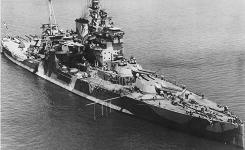
HMS Queen Elizabeth
(MaritimeQuest)
G e n e r a l
I n f o r m a t i o n
Four
ships of this Class to be built to a design designated R3 were ordered
during the latter half of 1912. After an offer by the Federated Malay
States to pay for an additonal ship, a later order was placed for a
fifth. In the 1914-15 Estimates a sixth ship was included but this
requirement was cancelled in August 1914.
These
ships, identified as the QUEEN ELIZABETH Class were :
|
Name |
Builder |
Laid Down |
Launched |
Completed |
Remarks |
|
QUEEN ELIZABETH |
HM Dockyard,
Portsmouth |
21.10.12 |
16.10.13 |
1.15 |
Scrapped Dalmuir
1948 |
|
WARSPITE |
HM Dockyard
Portsmouth |
31.10.12 |
26.11.13 |
3.15 |
Wrecked on
passage to shipbreakers. |
|
VALIANT |
Fairfield |
31. 1.13 |
4.11.14 |
2,15 |
Scrapped Cairn
Ryan 11.48 |
|
BARHAM |
John Brown |
24. 2.13 |
31.12.14 |
10.15 |
Sunk by U331.
25.11.41 |
|
MALAYA |
Armstrong |
20.10.13 |
18. 3. 15 |
2.16 |
Named after
Donor. Scrapped Faslane 4.48 |
|
AGINCOURT |
- |
- |
- |
- |
Order cancelled
8.14 |
Main
propulsion was provided by direct drive steam turbines of 75.000 shaft
horse power driving four shafts to give a designed speed of 24 knots.
Deep
Displacement of these ships varied between 32,910 and 33,410 tons.
Improved armour protection was provided compared with the IRON DUKE
Class and Included 13in and 6in plates for hull structure, and upper
deck. In addition protection was provided for gun mountings and fire
control positions.
The
basic dimensions were: Length overall : 640 feet Beam : 90 feet Mean
Deep Draught : 32 feet.
Main
armament comprised eight guns 14in guns in four twin with twelve 6in
guns fitted In Barbettes as secondary armament. In addition two 3in guns
were fitted for air defence. 4 submerged 21in torpedo tubes were
included in the basic design.
A
flying-off platform for an aircraft was fitted to one of the forward
15in turrets but this was removed in 1934.
The
Complement was 953 (967 as a Flagship).
Modernisation and
Reconstruction
HMS
WARSPITE, HMS QUEEN ELIZABETH and HMS VALIANT underwent a reconstruction
when they were modernised. The other ships although extensively refitted
were not subject to very major structural changes nor were they fitted
with dual purpose 4.5in guns. During the modernisation of HMS QUEEN
ELIZABETH beginning in 1937 the bridge structure was redesigned and the
secondary armament was replaced by 10 twin 4.5in mountings to give an
effective defence against air attacks whilst also retaining surface
capability by using dual-purpose design mountings. Modern close range AA
guns were also fitted.
The
direct drive turbines were replaced by geared turbines and new design
boilers were installed. The whole of the machinery arrangements were
modified in order to improve the damage control facilities. A catapult
facility with two cranes was fitted for operating a seaplane aircraft.
These were removed when war experience showed this to be of
limited value.
The
recent development of radar to provide warning of the approach of
aircraft and for armament fire-control, which had been undertaken prior
to 1940, allowed this essential equipment to be fitted during
modernisation. Additional radar sets were fitted during WW2 refits and
replacements fitted for existing outfits during wartime refits for
existing sets . (See War
Service details).
As a
result of all these alterations the deep displacement increased to
36,080 tons and the Complement increased to 1200 after modernisation. By
1945 both had again increased due to the installation of additional
equipment and the need for more personnel to man, maintain and support
the new facilities
War Service
Between
September 1939 and August 1945 all ships of the Class saw extensive
service in Home Waters and abroad. They were deployed for trade defence
to protect shipping against attacks by German commerce raiders and took
part in most major naval operations. Their extensive deployment resulted
in damage by surface, air and submarine attacks and one of the Class,
HMS VALIANT, was taken cut of service when seriously damaged when she
was under maintenance in a Floating Dock at Trincomalee which collapsed
In August 1944
Two of
the Class, HMS VALIANT and HMS QUEEN ELIZABETH, were also badly damaged
after an underwater attack by Italian frogmen who attached Limpet Mines
to their hulls whilst at anchor in Alexandria. Both ships had to undergo
extensive repairs and were taken cut of operational service in 1941 at a
critical time during WW2.
HMS
WARSPITE is perhaps marginally the most famous of the Class. She was in
action with German and Italian surface warships, supported many Malta
convoys as well as carrying out bombardments to support of allied
military
operations in North Africa. Her crowning glory was to lead the
surrendered Italian Fleet into Malta after the capitulation of Italy in
September 1943. A few weeks later she sustained further serious damage
when hit by a radio controlled glider bomb off the Salerno beachhead and
after several months out of service supported the allied landings in
Normandy. Despite detonating an acoustic mine off Harwich she resumed
these support duties and later carried out bombardments at Walcheren.
Her final end was, in many ways, just as well remembered as her wartime
service, since she ran aground in Mounts Bay, Cornwall when on passage
to the breakers yard under tow. Her eventual dismantling extended over
10 years.
Only one
ship of the Class was sunk during WW2. HMS BARHAM was hit in the eastern
Mediterranean by three torpedoes fired by U331 and sank within a few
minutes with heavy loss of life.
Further
details of the history these ships is available in BRITISH BATTLESHIPS
by Alan Raven and John Roberts and the history of HMS WARSPITE in
BATTLESHIP WARSPITE by V. E. Tarrant.
R O Y A L
S O V E R E I G N C L A S S
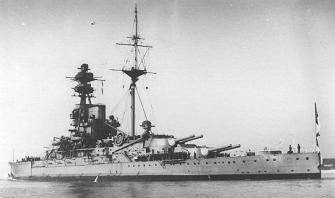
HMS Royal Sovereign
(NavyPhotos)
G e n e r a l
I n f o r m a t i o n
The five
ships of this Class were ordered under the 1913 Programme were designed
to use a combined coal and oil fuel supplies to provide steam for their
propulsion machinery. The Class comprised :
|
Name |
Builder |
Laid Down |
Launched |
Completed |
|
ROYAL SOVEREIGN
|
HM Dockyard,
Portsmouth |
15. 1.14 |
29.4.15 |
5.16 |
|
ROYAL OAK |
HM Dockyard,
Devonport |
15.1.14 |
17-11.14 |
5.16 |
|
RAMILLIES |
W. Beardmore,
Dalmuir |
12.11.15 |
12. 9.16 |
10.17 |
|
REVENGE |
Vickers |
22.12.13 |
29. 5-15 |
3.16 |
|
RESOLUTION |
Palmers |
29.11.13 |
14. 1.15 |
12.16 |
Main
propulsion was provided by direct drive steam turbines of 40,000 shaft
horse power driving four shafts to give a speed of almost 22 knots.
Deep
Displacement of these ships varied between 31,160 and 33,540 tons.
Armour protection included 13in and 6in plates for hull structure, and
upper deck, addition protection was provided for gun mountings,
magazines and fire control positions. Dimensions on completion were
620ft length overall, beam 102ft ft and draught of 30ft.
Main
armament comprised eight 14in guns in four twin turrets with 14-6in guns
fitted as secondary armament. In addition two 3in guns were fitted for
air defence and also four submerged 21in torpedo tubes.
Design Changes
Early
modifications during build was the conversion to use only oil fuel and
to Increase the shaft horsepower from 31,000 to 40,000 which reduced the
number of stokers required by 75. The four guns aft on the main deck
were replaced by 2 single mountings fitted on the Forecastle Deck. Main
armament directors were fitted in all ships and, in RAMILLIES only,
bulges were added to improve protection against under water explosions.
She was the first modem RN capital ship to have these fitted although
their design was changed in post WW1 refits.
Whilst
in service the remaining ships were fitted with bulges of modified
design and the damage control arrangements ware improved. Armour
protection was added to main deck over the magazines to incorporate
lessons from the Battle of Jutland and the hull structure forward was
strengthened. A flying-off platform for an aircraft was fitted to both B
and X turrets. The Kite-balloon winches fitted during WW1 in REVENGE,
RAMILLIES and RESOLUTION were removed after the war. The original 15
foot range finders in B and X turrets were replaced.
The
changes made between 1930 and 1946 in the ships of this Class differed
widely but in spite of their poor condition. Aircraft arrangements and
anti-aircraft defence were much improved and the torpedo tubes were
removed in all five. During WW2, apart from the fit of radar, additional
AA weapons, damage control changes and removal of the aircraft there
were few other significant changes.
War Service
HMS
ROYAL OAK was sunk in Scapa Flow In October 1939 but the other ships
survived WW2. Although used extensively for trade defence during 1939-40
ships of this Class took part in operations in Norway and at Dakar.
Their low speed and poor defence against attack by aircraft showed that
they were not suitable for fleet duties and they were deployed In the
Indian Ocean for defence of convoys. By 1943 they had all been relegated
to training duties although HMS RAMILLIES provided gunfire support
during landings in Normandy and in the South of France. HMS ROYAL
SOVEREIGN was lent to the Soviet Navy in 1944 and was renamed
ARKHANGELSK. The four ships surviving WW2 had all been scrapped by 1949.
K I N G G E O R G E
V C L A S S
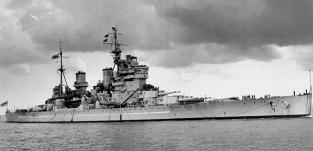
HMS King George V (MaritimeQuest)
G e n e r a l
I n f o r m a t i o n
HMS
DUKE
OF YORK was ordered under the 1937 Estimates with HMS
ANSON and HMS
HOWE. Two others of this Class had been covered by the 1936 Programme
and construction of the two ships had begun on 1st January 1937. The
need for new modern battleships had been felt essential by the Admiralty
since 1927 to counter build of this type of warship by Italy and France.
Several conceptual designs had been drawn-up by the Naval Construction
Department but the final four produced after 1935 had to take into
account the limitations imposed by the by the London Naval Treaty
re-affirmed in 1930. In July 1936 the design agreed was for a main
armament of ten 14in guns arranged in two quadruple turrets and one twin
turret instead of three quadruple turrets. As a result of the weight
saving it was possible to provide increased magazine protection and
still conform to the Treaty requirements. This change was needed to
counter the improved penetration of modern shells. In hindsight it is
clear that this was based on experience in WW1 and inadequate for the
different conditions to be faced in modern sea warfare.
As
designed the standard displacement was 35,490 tons with a waterline beam
of 103 feet. During build and war service due to changes in equipment.
Standard Displacement of
KING
GEORGE V in 1945 was 39,100 tons. Ships of
this Class had an overall length of 745 feet with a waterline beam of
103 feet and a draught of 28 feet at standard displacement.
The main
armament was fitted in two quadruple mountings, fitted forward and aft,
with a twin 14in mounting sited forward above the quadruple mounting.
Eight twin 5.25in mountings with a surface and anti-aircraft capability
comprised the secondary armament. In addition, Close Range AA defence
was provided by four eight barrelled 2 pdr pom-pom guns on build and
supplemented in service by 20mm Oerlikon and 40mm Bofor guns as well as
additional pom-pom mountings.
Radar Equipment
This
Class was fitted with some outfits on build and as more equipment was
developed the radar fit was very significantly improved throughout war
service. Details of the function of the various equipments are as
follows but reference should be made to RADAR AT SEA by D Howse for
further information about the development and use of radar in the RN.
|
Long Range
Aircraft Warning |
Type 279, a
production variant of the first equipment for naval use, was
fitted in KGV on build. Two aerial units were required and
were sited on the main and fore masts. Prior to deployment
in the Pacific, Type 279B a modified set was fitted which
required only one aerial which was sited on the mainmast.
The remaining three ships were fitted on build with an
improved equipment Type 281 which was replaced by a single
mast variant, Type 281B in 1944. |
|
Main Armament
Fire-control |
Type 284, the
development of which was completed soon after the outbreak
of war was fitted during build in all ships with the its
aerial mounted on the Forward Director and provided data for
control of the two forward mountings. During 1944-45 this
equipment was replaced by a much improved equipment Type 274
and a second outfit was fitted to the After Director in the
three ships in service. |
|
Secondary 5.25in
Fire-control |
Type 285, which
was a variant of Type 284 was fitted after build completion
in all ships with the aerial fitted on the HA Director
associated with each pair of twin gun mountings. These
equipments were replaced after 1944 by Type275 which was a
variant of Type 274 used for the main armament. |
|
Close Range
Armament |
Type 282, another
variant of Type 284 was fitted during or soon after build
with aerial mounted on Director controlling Pom-Pom
Mounting. Number fitted varied between ships and some were
fitted during build with additional during service. Planned
replacement was Type 262 developed towards the end of WW2
but was not implemented in the remaining four ships during
war. |
|
Surface Warning |
Type 271 which
was development during WW2 was fitted in KGV and DoY during
service and a prototype modified variant which later became
Type 273 was fitted in PoW before she sailed for Singapore.
Production models of this new improved version were fitted
during the build of the other two ships. In final wartime
refits of these four ships the newly designed Type 293 and
Type 277 were fitted. This latter outfit had a dual
capability allowing its use for aircraft height finding.
These sets and also Type 281B/279B had Plan Display units
fitted in an Operations Room where all radar information
could be assessed. |
|
Miscellaneous |
Special radar
Interrogation outfits which enabled Friendly ships and
aircraft to be identified were fitted during service. Type
243 was used in conjunction with Aircraft Warning radars and
Type 242 with the Surface Warning sets. A Transponder Type
253 which replied to the challenges by Interrogators. |
As
designed ships of this Class were to carry four amphibian aircraft but
before completion this was reduced to two. A catapult was fitted for
launching and cranes were used for their recovery. In later refits
aircraft and catapult were landed as war experience and the availability
of radar established their limited value.
Four
three bladed propellers driven by steam turbines with a shaft horsepower
of 100,000 produced a speed of 27 knots in service. The endurance as
designed was never achieved and compared unfavourably with similar US
and German battleships. The arrangement of the machinery was in four
separate Units which could operate independently to ensure propulsion
was available in the event of damage in action or collision.
Considerable armour protection against gunfire and was provided in the
original design for magazines, machinery compartments, main and
secondary gun mountings. Protection was also provided against torpedo
attack by a system of compartments along the side of the ship which was
criticised as being insufficient after the loss of HMS
PRINCE
OF WALES.
The damage control arrangements were also improved as a result of the
sinking. De-gaussing was fitted during build for protection against
magnetic mines.
The most
significant design weakness in this Class was the lack of freeboard
particularly in the bow due to the increase in displacement after
additional equipment was added during the build. As a result the ships
were very wet forward, even in moderate sea conditions which affected
gunnery performance.
War
experience especially in Arctic conditions, demonstrated the need for
better protection of equipment in severe weather conditions. As designed
the Complement was 1,409 but this had increased to over 1,550 by 1945
due to the requirement for personnel to operate and support the
additional equipment fitted. Despite their shortcomings these ships gave
magnificent service and their very existence did much to ensure that
attacks on Atlantic and Arctic convoys were prevented.
B A T T L E
C R U I S E R S
R E P U L S E
CLASS

HMS Repulse (MaritimeQuest)
G e n e r a l I
n f o r m a t i o n
Four
battleships of the ROYAL SOVEREIGN Class ordered in May 1914, but were
cancelled in August 1911 after the outbreak of WW1. In December that
year, at the instigation of Admiral Fisher orders ware placed for two
battlecruisers to be named
REPULSE and
RENOWN. These ships were intended
to be faster than the existing but to retain the same armament at the
expense of armour protection. Build time was intended to be 15 months
and fitting of new propulsion machinery was not approved because of this
factor.
HMS
RENOWN was laid down by Fairfields in January 1915, launched on 4th
torch 1916 and completed on 20th September that year. Main propulsion
was provided by steam turbines of 120.000 shaft horse power driving four
shafts to give a speed of 32 knots during trials. As designed their Deep
displacement was 30,385 tons but this Increased to 36,080 tons by 1939
after modernisation. Both ships ware 794 feet long overall and had a
beam of 90 feet with a deep draught of 30 feet. Their main armament
comprised six 16in guns in three twin turrets with 17 four inch guns as
secondary armament and two 3in High Angle Guns for A A defence. A
proposal to carry 25 mines was not implemented. Both ships had two
underwater torpedo tubes fitted forward. After completion flying-off
platforms were fitted to two of the 15in gun turrets. Although armour
protection was provided for decks and also to safeguard gunnery
positions this was not as substantial as in the battleships built at the
same period. The extent of Deck protection was increased in 1916 after
completion following war experience.
In 1919
HMS RENOWN was selected to take HRH The Prince of Wales for a visit to
Australia and underwent a refit to make changes to provide suitable
accommodation for the Prince. Further refits in 1931 and 1933 allowed
improvement of the High Angle gun control and in addition a catapult was
fitted for a seaplane, but without any hangar for maintenance.
The ship
was modernised along the same lines as that for HM Battleship WARSPITE
between 1936 and 1939. Extensive changes were made to the secondary
armament which was replaced by ten twin 4.5in mountings with a dual
surface and AA capability-Changes to the aircraft facilities were made
including provision of hangars and two cranes for recovery. As part of
the modernisation the propulsion machinery was replaced to reduce weight
and provide new boilers. Auxiliary machinery using electrical power
instead of steam was fitted and this included electro-hydraulic steering
gear and an a electric capstan. In addition the protection arrangements
were slightly improved but restricted to avoid loss of speed. Originally
the Complement was 953 (967 as a Flagship) but this increased to 1200
after modernisation and to 1453 by 1945 due to the need to operate and
support the additional equipment fitted during WW2.
Between
September 1939 and August 1945 this ship saw extensive service in Home
Waters, the Mediterranean and in the Indian Ocean as described in the
Chronology of War Service. She was deployed for defence of military and
trade convoys as well as for the support of shore operations in Norway
and in the East Indies. HMS RENOWN was damaged in action off Norway in
1940 with the German battleships GNEISENAU and SCHARNHORST and took part
in the search for the German battleship BISMARCK in May 1941. She
brought Winston Churchill back to UK after the QUADRANT conference at
Quebec with Franklin Roosevelt. In 1941 radar equipment was installed
and during a refit in 1943 before being deployed in the Indian Ocean her
aircraft facilities were removed and additional close range weapons were
fitted for defence against aircraft.
Because
of the very significant addition of equipment the ship's displacement
increased by over 2,300 tons which gave rise to concern. The ship
returned to UK from duty in the Indian Ocean during March 1945 for
further reconstruction to reduce weight starting In October. This was
cancelled in September and the ship deployed at Devonport for training.
However her final duty in the active Fleet was to be used by HM King
George VI when he met the Mr Truman the US President at Plymouth on 2nd
August 1945. HMS RENOWN reduced to Reserve status in December 1946 and
was placed on the Disposal List in 1948. She arrived at Faslane to be
broken up on 8th August 1948.
H O O D C
L A S S
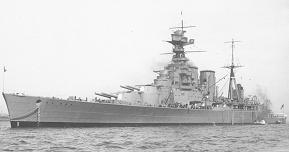
HMS Hood (MaritimeQuest)
G e n a r a l I n
f o r m a t i o n
HMS
HOOD
was ordered at 7th April 1916 with HM Battlecruisers HOWE and RODNEY. A
fourth ship of this Class HMS ANSON was in July that year. The design
had been under consideration for almost a year and of the final four
variants proposed, the modified Design A was chosen. The details were
altered after the Battle of Jutland but these were shown to be
inadequate when this ship was lost in May 1941. Although four of the
Class were laid down, three were cancelled and only HMS HOOD entered
service. It is beyond question that this battlecruiser was considered to
be the most graceful Royal Navy ship in September 1939 when war was
declared and her loss came as a great shock, especially to all RN
personnel. For details of the design changes between 1915 and 1920 see
BRITISH BATTLESHIPS by A Raven and J Roberts.
Main
propulsion was provided by single reduction steam turbines of 144,000
Shaft Horse Power driving four shafts to give a speed of 31.9 knots
during trials. As designed the Deep Displacement was 46,680 tons, with a
length overall of 860 feet 7 inches, a Beam of 104 feet 2 inches and
deep draught of 32 feet.
The main
armament comprised eight 14in guns in four twin turrets. These were of
modified design which allowed a maximum elevation of 30 degrees instead
of 20 degrees following experience in the Battle of Jutland. Secondary armament
fitted was 12-5.5in and four High Angle single 4in guns for AA defence.
The ship was also fitted with two underwater torpedo tubes and four deck
mounted torpedo tubes. Armour protection was provided for upper decks,
and bulkheads with side armour to protect weapon mountings and control
positions for fire control equipment. Bulges were provided for
underwater hull protection. An aircraft flying-off platform was fitted
on X Turret aft. For details see above reference.
During
further refits before WW2 the Bridge was modified and range finder
arrangements changed. Extensive
improvements were made to improve AA defence and the aircraft platform
was removed as its use had proved unsatisfactory for this design of
ship. The submerged torpedo tubes were also removed. Improvements were
made to communications equipment and to positioning of searchlights.
All
secondary armament was changes before 1940 having been replaced by dual
purpose twin 4in weapons. During the refit in 1940 a degaussing cable
was installed to give protection against magnetic mines. Radar outfits
were also fitted for aircraft warning and for main armament fire control
by 19409.
A
proposal made in December 1938 to carry out an extensive reconstruction
was never implemented because of the anticipated outbreak of war with
Germany. The main machinery would have been replaced and aircraft
facilities fitted including hangars. The Bridge structure was intended
to be re-designed as had been already done in some of the QUEEN
ELIZABETH Class battleships. Significant improvements were intended to
armour protection, but whether these would have prevented the sinking by
BISMARCK cannot be assumed. Her loss was the subject of a Board of
Inquiry amongst the comment on its findings was the suggestion that the
sinking may have been due to explosion of torpedo warheads adjacent to
the point of contact of the fifth salvo. See above reference and the
Naval Staff History Battle Summary.
Originally the Complement was 1,397 but due to the provision of
additional anti-aircraft weapons as well as radar equipment this would
have progressively increased. At the time of her sinking over 1,400
personnel were killed.
Between
initial commissioning on 14th May 1920 and September 1939 the ship
served mainly in Home waters and in the Mediterranean. She was held in
high esteem not only by those who manned her but by all associated with
the Royal Navy from 1920 on. During her service in WW2 she was
extensively deployed for Home Fleet operations and for Atlantic convoy
defence.
M O N I T O
R S
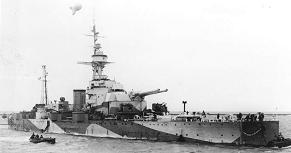
HMS Erebus (CyberHeritage)
G e n e r a l
I n f o r m a t i o n
This
type of warship was designed for the support of shore military
operations. These ships were armed with two 15in guns mounted in a
turret which was sited forward of the bridge.
The
Monitors in service in September 1939 were :
|
MARSHAL NEY
|
Disarmed and used
as an accommodation ship at Devonport. |
|
MARSHAL SOULT |
Attached to the
Gunnery School at Chatham for training purposes, Disarmed in
1940 and used as an accommodation ship, |
|
EREBUS |
Attached to the
Gunnery School at Portsmouth. Used as a training ship for
naval cadet. and had been specially modified for this duty
with additional cabins on the upper deck. |
|
TERROR |
Deployed at
Singapore with the Local Flotilla. |
Two
ships of this type, HMS
ROBERTS and HMS
ABERCROMBIE were completed after
1939 and deployed operationally during WW2.
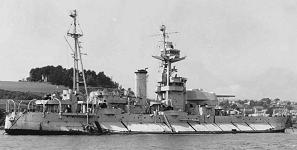
HMS Roberts (NavyPhotos)
G e n e r a l
P a r t i c u l a r s
|
Displacement |
7,850 Tons
(Except ROBERTS 7,970 Tons) |
|
Length |
373 feet Beam 90
feet Draught 12 feet. |
|
Machinery |
Geared turbines
(4,800 SHP) driving 2 shafts. Speed: 12 knots. |
|
Armament |
1 Twin 15in
Mounting; 4 twin 4in; 2 Pdr pom-pom (1x8 and 2x8) |
|
Armour |
Provided for
Deck, hull , gun mountings and steering gear. External
bulges were fitted to hull for protection against torpedoes. |
|
Complement |
350 |
W a r S e r v i c e
HMS
ROBERTS served in the Mediterranean from 1942 and aupported many
operations in North Africa and Italy including the allied landings in
Sicily and at Salerno. On return to UK in 1944 she was deployed in
support of the Normandy landings and at Walcheren..
HMS
TERROR was deployed in the Mediterranean during 1940 and supported the
8th Army until being sunk by air attacks on 24th February 1941
HMS
EREBUS provided gunfire support during the evacuations from Europe in
1940 and later carried out bombardment of enemy positions in
France. In 1943 the ship went to support allied landings in Sicily. The
next year she returned to Home waters and also supported the Normandy
landings and the Walcheren assault operations.
For
further details of war service in WW1 and WW2 see MONITORS by I. Button
F L E E T
A I R C R A F T C A R R I E R S
H. M . S .
E A G L E
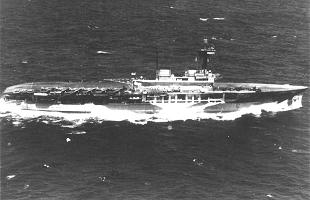
G e n e r a l
I n f o r m a t i o n
The
twentieth British warship to bear the name
EAGLE. This ship had been
ordered from Armstrong's as a Dreadnought battleship by Chile in 1913
and was to have been named ALMIRANTE COCHRANE. However, after war broke
out in August 1914 work was suspended. The ship lay unattended on her
building slipway until 1917 when she was purchased by the Admiralty for
£1.3M. Her design was modified by aAdmiralty Naval Constructor, Sir. E.
H. Tennyson d'Eyncourt, to enable the ship to be used to carry aircraft.
For that reason she cannot be regarded as the first purpose built Royal
Navy aircraft carrier. The flight deck extended for the full length of
the ship which had no masts, only one funnel and no island structure.
The full
Load displacement was 26,400 tons with an overall length of 667 feet and
beam of 105 feet 9. She had a maximum draught of 27 feet. Geared
turbines with a shaft horsepower of 50,000 driving 2 shafts gave a speed
of 24 knots. Armour protection was provided for hull and decks. Her main
armament consisted of nine 6in guns for defence against surface ships
and she had four 4in guns for anti-aircraft defence. Before the outbreak
of war in 1939 eight 2Pdr pom pom guns were added for close range AA
defence.
Her
conversion was carried out by the builder Armstrong's at Elswick and the
ship was launched on 8th June 1918. After commissioning on 13th April
1920, flying trials were carried out off Sicily to assess performance in
the new role. As a result it was necessary to make modifications to the
existing arrangements. Work was undertaken at HM Dockyard Portsmouth
starting in November 1920 and did not complete until 1923. The changes
made also took into account the experience gained in other trials
carried out by the other carriers which had showed the need to have an
island structure for control of flying operations and for ship handling.
This feature was provided in the revised design and was sited on the
starboard side. It incorporated two funnels and two masts, the forward
one of which had a gunnery fire control position at its top. HMS EAGLE
had therefore a distinctive appearance, quite different from any other
RN aircraft carriers.
Originally her complement was 748 but this increased to over 1150 during
WW2. The ship was intended to carry 21 aircraft and the hangar design
included two levels. When finally accepted into service the ship and its
various alterations had cost £4.6M.
HMS
EAGLE was serving on the China Station in 1939 and transferred on the
outbreak of war to the Indian Ocean. She went to the Mediterranean in
June 1940 and took part in several Fleet operations. Despite her slow
speed and limited operational capacity she was used extensively for
defence of Malta supply convoys and to take aircraft for the
reinforcement of Malta. She was lost whilst covering the passage of a
Malta convoy in August 1942 when torpedoed by U73 south of Majorca. The
ship sank quickly but 900 of the crew of 1160 were rescued.
C O U R A G E O U S
C L A S S
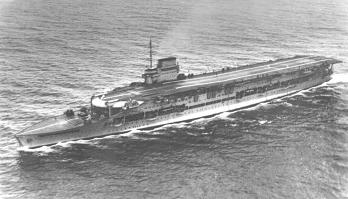
HMS Courageous (NP/Mark
Teadham)
G e n e r a l I n f o r m a t
i o n
The second
British warship to bear the name GLORIOUS, first used for a French 74 gun
ship captured at the Battle of The Saintes in 1782, but foundered five
months later. This ship was designed as a light battlecruiser and ordered in
1915 with another of the same type to be named COURAGEOUS. They were part of
a project initiated by the renowned Admiral Sir John Fisher for operations
in shallower waters such as the Baltic Sea. A similar battlecruiser, HMS
FURIOUS was ordered at the same time for the same type of deployment and had
a main armament of 18in, guns the eaviest ever used in a British warship. All
three ships were converted for use as aircraft carriers by 1930.
HMS
COURAGEOUS was ordered from Armstrong's Elswick shipyard in Newcastle and
HMS
GLORIOUS from Harland and Wolf at Belfast. Both ships were completed in
1917 and had a deep displacement of about 23,000 tons. They were 786 feet in
overall length with a beam of 81 feet 9 inches outside bilges and had a
draught of 24ft at standard displacement. Armour protection was provided as
fitted in C-Class cruisers. During the sea trials of HMS COURAGEOUS in 1917,
heavy weather conditions showed signs of strain on the forward part of the
hull. Doubling plates were fitted to strengthen the structure in both ships.
Aircraft platforms on the A and Y-turrets were used for two aircraft in line
with the current policy. The build cost for each ship was £2.1M.
After the
better armed and protected RENOWN Class battlecruisers joined the Fleet the
two COURAGEOUS Class became of limited vale and were considered to be white
elephants. Their selection for full conversion into aircraft carriers was a
sign of the recognition within the Admiralty that purpose built ships of
this type were an essential need.
COURAGEOUS
Class ships were originally fitted with 2 twin 15in guns and a secondary
armament of 6 triple 4in mountings, which were never considered a successful
design. After a short period in service they were taken in hand for
conversion to their new role in Royal Dockyards between 1924 and 1927. Their
armament was then replaced by 16 dual purpose 4.7in guns which could be used
against surface and aircraft targets. In addition they had some smaller AA
weapons. The torpedo tubes fitted originally were removed.
The
propulsion machinery consisting of four propellers driven by steam turbines
of 90,000 shaft horsepower provided a a speed of 31.58 knots during trials
following conversion. 18 Yarrow type boilers fitted in three compartments
were used. After conversion, the ships carried 48 aircraft and had an island
structure on the starboard side of the flight deck which included the funnel
and bridge. This feature distinguished the Class from HMS FURIOUS which had
no funnel visible.
The designed
Complement after conversion was 748 excluding the aircrew and support
personnel who were largely from the RAF in these two ships. Various
modifications were made before 1939 including installation of 21pdr pom-pom
AA weapons for use in close range AA defence.
Both HMS
COURAGEOUS and HMS GLORIOUS were sunk in the first ten months ofWW2. Neither
ship was fitted with radar and no significant changes were made to their AA
armament. In each case their sinking was due to misuse. HMS COURAGEOUS was
deployed on anti-submarine patrols with insufficient protection and sank
after being hit by torpedo from a U-Boat on 17th September 1939. HMS
GLORIOUS was sunk in action with the German battleships SCHARNHORST and
GNEISENAU when returning to UK from Norway after the allied evacuation. The
fact that none of her aircraft were being used to provide any warning of the
presence of enemy warships was a major factor in her tragic and unnecessary
loss.
I L L U S T R I O U S
C L A S S E S
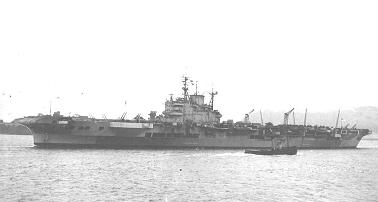
HMS Illustrious (NavyPhotos)
G e n e r a l
I n f o r m a t i o n
The second
generation of Fleet Aircraft Carriers comprised six ships. ILLUSTRIOUS Class
ILLUSTRIOUS
built by Vickers Armstrong at Barrow.
VICTORIOUS
built by Vickers Armstrong at Newcastle on
Tyne.
FORMIDABLE
built by Harland and Wolff at Belfast.
During build
it was decided to incorporate new features in these ships but owing to their
advanced build status it was only possible to incorporate a second half-size
aircraft hangar on the deck below the main hangar. This Class was slightly
larger than that of HMS ARK ROYAL. These ships displaced 23,000 tons and had
a length of 95 feet with draught of 24 feet. As designed they carried a main
armament of 8 twin 4.5in High Angle mountings for defence against aircraft
and surface ships with six 8 barrel 2 pd Pom Pom mountings for Close Range
AA defence. Later these were replaced by 20mm Oerlikon mountings. The
initial design allowed for 36 Aircraft but this increased to over 60 later
in WW2 although varied when heavier machines were available. The main
propulsion machinery consisted of geared turbines with a shaft horsepower of
110,000 giving a speed of 31 knots. Initially their Complement was about
1400 but this increased later when more guns and new equipment e.g. , radar
was fitted.
Armour
protection was provided for the hangars, upper deck and machinery
compartments. The availability of an armoured Flight Deck undoubtedly saved
these ships after being hit by Japanese KAMIKAZE aircraft in the Pacific
during 1945.
Modified ILLUSTRIOUS Class
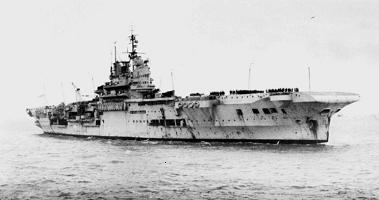
HMS Indomitable in 1946
(MaritimeQuest)
INDOMITABLE
built by Vickers Armstrong at Barrow.
HMS
INDOMITABLE had a displacement of 22,600 tons as designed and was 751 feet
in overall length with a beam of 953 feet and mean draught of 294 feet. The
other particulars were as for the earlier ILLUSTRIOUS Class.
IMPLACABLE Class
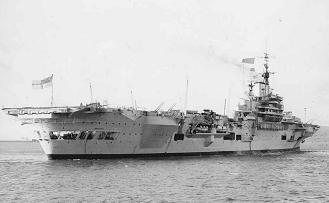
HMS Implacable in 1952 (NavyPhotos)
IMPLACABLE
built by Fairfield at Govan
.
INDEFATIGABLE
built by John Brown at dydebank.
The full
range of changes were incorporated during the build of the last two ships
which became known as the IMPLACABLE Class. Amongst the changes made were
provision of four sets of turbine machinery driving four shafts which gave
an increase in designed speed.
None of the
six Fleet Aircraft Carriers of these Classes which were all completed during
WW2, was lost during WW2.
P o s t W a r S e r v i
c e
HMS
FORMIDABLE and HMS INDEFATIGABLE were put into Reserve in 1948 and never
used in the operational Fleet after that date.
HMS
ILLUSTRIOUS was mainly used for trials purposes until laid up in 1954.
HMS
IMPLACABLE remained operational until 1950 when she was used for training
purposes.
HMS
INDOMITABLE was extensively modernised and her bow and stem rebuilt between
1948 and 1950. She then became Flagship of the Home Fleet until 1954 when
placed in Reserve.
HMS
VICTORIOUS was extensively modernised between 1950 and 1958, again refitted
in 1962-3 and then remained operational until 1967 when taken out of use.
L I G H T
F L E E T A I R C R A F T C A R R
I E R S
C O L O S S U S
C L A S S
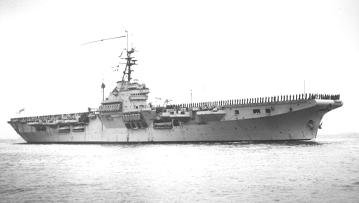
HMS Colossus
(NP/Mark
Teadham)
G e n e r a l I
n f o r m a t i o n
Ten Light
Fleet Aircraft Carriers of the COLOSSUS Class) were ordered under War
Emergency Build Programmes in 1942 - 43. These ships were not as big as the
earlier Fleet Aircraft Carriers (ILLUSTRIOUS Class) and were not able to
carry as many aircraft. Although intended primarily for use in defence of
convoys as replacement for the US Type CVE, they were fitted with the
equipments needed to carry out Fleet duties. None of this type were
completed before hostilities ended in August 1945.
They were
built to Lloyds Specification for merchant ship construction up to Main Deck
level. This was to enable them to be converted for use as mercantiles after
the end of the war. However all COLOSSUS Class Light Fleet Carriers were
used in the Fleet role and remained in naval service with the Royal Navy and
those of other foreign countries.
|
Ship |
Naval Service |
|
COLOSSUS |
French, from 1951 after loan (ARROMANCHES) |
|
PERSEUS |
British. Used as a Maintenance or Supply Carrier. Scrapped in
1958. |
|
GLORY |
British until scrapped in 1961. |
|
PIONEER |
British. As for PERSEUS. Scrapped in 1954. |
|
OCEAN |
British until scrapped in 1952. |
|
THESEUS |
British until scrapped in 1962 |
|
TRIUMPH |
British until scrapped in 1980. |
|
VENERABLE |
Netherlands since 1948 (KAREL DOORMAN). |
|
VENGEANCE |
RAN loan until 1956. Brazil from 1957 (MINAS GERAIS) |
|
WARRIOR |
Argentine from 1958 (INDEPENDENCIA). |
Ships of
this Class had a displacement of 13,350 tons (Standard) or at Full Load
18,500 tons. With an overall length of 695 feet and a beam of 80 feet they
had a mean draught of 21 feet (23 feet at full load). The propulsion machinery
consisted of steam turbines with 42,000 Shaft Horsepower giving a speed of
25 knots. Design arrangements included the use of a 'Unit' system to improve
damage control. Endurance: 12,000 miles at 14 knots.
Ships other
than the Maintenance carriers had multiple 2Pdr pom-pom and 40mm AA
mountings for close range defence against aircraft .The original complement
was 850 excluding aircrew and maintenance personnel but this increased
significantly as more equipment was fitted. Radar equipment was fitted for
aircraft control, surf ace warning and for navigation purposes with radio
communication outfits for direction of aircraft and standard naval
requirements.
Between 39
and 43 aircraft could be embarked, depending on type. Fixed wing aircraft
were used until helicopter development for naval use was completed in
1960's. Rotary wing aircraft were extensively then used in aircraft
carriers. s shown in the above Table all ships of this Class retained in the
RN had been taken out of service as aircraft
carriers or
were transferred to foreign navies by 1959-
H E R M E S C L
A S S
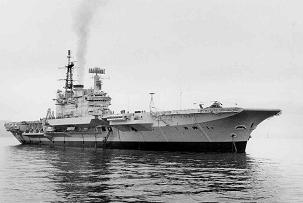
HMS Hermes (NavyPhotos)
G e n e r a l I
n f o r m a t i o n
These eight
ships were ordered under an Emergency War Build Programme in 1944 but at the
end of hostilities with Japan the orders for four ships were cancelled. Work
on the other four partially built hulls was stopped until 1946 when
construction was re-commenced. The name of HMS ELEPHANT was changed to
HERMES in 1945 to ensure that this famous name could be retained in
the post war Fleet. This design of this ship was improved to include post
war developments such as the angled deck and steam catapult. Later in 1971
she was converted for use as a Commando Carrier with extensive design
changes to meet the new role. After another 17 years service she was placed
on the Disposal List and sold to India.
|
Name |
Builder |
Laid Down |
Launched |
Completed |
Remarks |
|
ALBION |
Swan Hunter |
22.03.44 |
06. 05..47 |
26.05.54 |
Sold for use as Crane Ship 7.73 and scrapped 11.73 |
|
ARROGANT |
Swan Hunter |
1944 |
|
|
Cancelled |
|
BULWARK |
Harland and Wollf |
10.05.45 |
22, 06 48 |
04.11.5.4 |
Scrapped 1984 |
|
CENTAUR |
Harland and Wolff |
30.05.44 |
22. 04.47 |
01.09.53 |
Scrapped 1972 |
|
ELEPHANT |
Vickers Barrow |
21.06.44 |
16.02.53 |
18.11.59 |
Renamed HERMES. Re-categorised Class. Sold to India 1986 |
|
HERMES |
Cammell Laird |
21.06.44. |
- |
- |
Cancelled |
|
MONMOUTH |
Fairfield |
- |
- |
- |
Cancelled |
|
POLYPHEMUS |
Devonport Dyd |
- |
- |
- |
Cancelled |
General Particulars (On Build)
|
Displacement |
22,000 tons |
|
Dimensions |
Length 737 ft. 9 ins, Beam 123, ftDraught 26 ft |
|
Propulsion Machinery |
Geared Turbines providing 78,000 SHP driving 2 shafts. Speed 28
knots. |
|
Armament |
32-40mm |
|
Aircraft |
45 |
|
Complement . |
1,350 (with Squadrons embarked). |
E S C O R T A I R C R A F T C A R R I E R S
G e n e r a
l I n f o r m a t i o n
One of the
earliest lessons learnt in the first year of the Battle of the Atlantic was
the need for continuous air cover of convoys.
As few Coastal Command shore based aircraft were available, submarines were
able to approach convoys without the need to submerge until making an
attack. Once enemy aircraft operated from French bases any convoy
without fighter protection became an easy target, unless near a UK coast
In 1941 four
naval auxiliaries were fitted with a catapult to enable fighter aircraft to
be launched for defence of convoys. These vessels were known as Catapult
Armed Merchant Ships (CAM Ships). The greatest disadvantage was that the
aircraft could not be recovered and the pilot, after using his parachute had
rely upon rescue by one of the ships in the convoy. To overcome this feature
it was decided to fit a Flight Deck on a mercantile so that it was possible
for an aircraft to take off and land. The first ship converted was the Ex
German mercantile HANNOVER captured in 1940 and renamed EMPIRE AUDACITY.
Commissioned as HMS AUDACITY she had very successful, but brief career which
confirmed the over-riding importance of this solution to effective air cover
from a ship in the convoy. HMS AUDACITY
was torpedoed in December 1942 in defence of Atlantic Convoy HG76 on passage
to UK from Gibraltar.
She was the first Escort Aircraft in the Royal Navy designed specially for
convoy defence. This type of warship is
known as a CVE in the US Navy.
In addition
six Grain Carriers and four Oil Tankers being built in UK shipyards together
with nine other Oil Tankers in service were also converted. These ships,
manned by civilian crews were known as Merchant Aircraft Carriers (MAC
Ships.) They performed a duel role as they carried cargoes as well providing
anti-submarine protection during passage. The number of aircraft carried was
limited to four SWORDFISH and no hangar was available for maintenance or
protection from the weather.
MAC and CAM
ships were an interim solution to this need whilst a more suitable
conversion was in hand to the British Escort Aircraft Carriers. In addition
to having a Flight Deck, a hangar was available and better AA defence as well as
carrying 15 aircraft which did not have to remain on the Flight Deck. More
importantly the CVE was fitted with radar and communication equipment
essential for aircraft direction and control of anti-submarine operations. A
fifth mercantile PRETORIA CASTLE deployed as an Armed Merchant Cruiser was
also converted for use as a CVE and use for deck landing training.
No other
conversions were made in British shipyards as the US Navy had already begun
mass-production of this type of aircraft carrier, some of which were to be
supplied to the Royal Navy under the UK/US Lease Lend Agreement. As
a result
British shipyards were able to concentrate on build of anti-submarine
escorts and much larger and adaptable Light Fleet Aircraft Carriers which
could be used for either Fleet or Convoy defence
During
1943-45 CVEs were deployed extensively with Support Groups in defence of
Atlantic and Arctic convoys. Their aircraft were responsible for the sinking
of many U-Boats and the air cover they provided ensured the safe passage of
many hundreds of ships.
When more
CVEs became available they were deployed in the Mediterranean for convoy
defence and for support of
shore
operations. After the end of hostilities with Germany in May 1945, 24 of
these ships served in the Eastern Fleet and the British Pacific Fleet and
carried out a variety of duties.
General Comparisons
|
|
CAM
Ships |
MAC
Ships |
CVE
(UK) |
CVE
(US) |
|
Number Built |
4 |
19 |
6* |
39 |
|
Displacement (Tons) |
Varied |
Varied |
11,000 - 17,000 |
11,000 |
|
Length (Feet) |
Varied |
430 |
470
- 510 |
492 |
|
Machinery |
Varied |
Diesel |
Diesel |
Varied |
|
Aircraft Carried |
1 |
4 |
15 |
18-24 |
* Audacity, Activity, Campania, Pretoria
Castle, Nairana, Vindex

HMS Audacity (CyberHeritage) (no
enlargement)
Nominal List
of Escort Aircraft Carriers (CVE)
U . S.
- B U I L T E S C O R T A I R C R A F T C A R R I
E R S
General
Information
As a result
of the close relationship between the Royal Navy and the US Navy the need
for convoy escorts to include a warship able to provide air cover was
quickly recognised. Two mercantiles under construction in the USA were
requisitioned and orders placed for them to be converted for use as
auxiliary aircraft carriers .designated CVE. One of these two ships was
transferred to the RN under the UK/US Lease-Lease Agreement in response to
an order for 6 ships of this type.
ARCHER Class
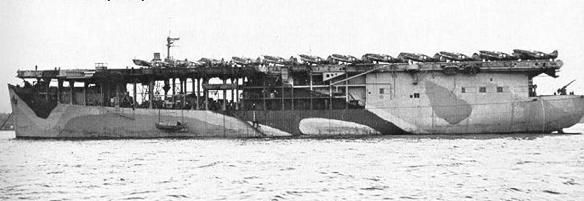
HMS Archer (NavyPhotos)
The Lead
Ship (Ex MORMACLAND) became HMS ARCHER and was completed to the design of
the US Navy CVE USS LONG ISLAND. Although five others were ordered one was
retained by the USN and was used for training British aircrew. Ships of this
Class, unlike the British built CVE HMS AUDACITY had a hangar extending for
half the length of the Flight Deck with a lift at one end. Diesel engines
provided main propulsion using a single shaft. One engine in HMS ARCHER and
two in remainder. A single 5in US Navy gun mounting was fitted for Low Angle
defence and two 3in Anti-aircraft guns. Close range defence was provided by
40mm and 20mm weapons. British naval radar sets were fitted in this Class.
During RN service these ships proved unstable and ballast was added. The
petrol distribution system was modified after loss of HMS DASHER in 1943
following an explosion.
ATTACKER
Class
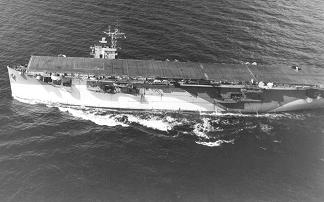
HMS Chaser (NavyPhotos)
Eleven ships
of this Class were obtained under Lend-Lease. Changes were made to the
ARCHER design and embodied in hulls already under construction for use as
mercantiles. Most significant were the use of steam turbine machinery and
provision of a larger hangar extending the full length of the Flight Deck.
Four sponsons were added on either side of the Flight Deck for installation
of additional Close Range anti-aircraft armament .Two 5in US Navy gun
mountings were fitted during build but later replaced by British guns. A
feature of ATTACKER Class ships was the selection of some specifically for
use during Assault landing operations. These variations were fitted with
special radar and communications equipment to control aircraft used for the
protection of ships during landing operations. Other ATTACKER Class were
fitted for convoy defence use as Escorts. Ships of the Class were fitted
with British radar outfits and could carry more aircraft.
RULER Class
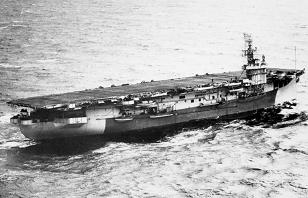
HMS Arbiter (NavyPhotos)
23 of this
last type were obtained under Lend-Lease and ordered from one US shipyard
(Seattle-Tacoma) for use as either Assault or Convoy Escort use. Build times
were reduced by the use of mass production techniques and some of this Class
were taken to US Navy or commercial shipyards for completion. In order to
further improve delivery times modification work to suit RN service was also
carried out on the west coast of Canada. Apart from the provision of more
Close Range anti-aircraft weapons the design followed that of the earlier
ATTACKER Class. US naval radar was fitted during build in all this Class and
included a fire control system for close range weapons. An increased
aircraft complement could be carried. Some ships fitted or used as Assault
Carriers were deployed for transport of aircraft.
Comparison
Table
|
Class |
Displacement
(Standard) |
Length
(Overall) |
Machinery |
Speed
(Knots) |
Armament
** |
Complement |
Aircraft |
Radar |
|
ARCHER |
13,000 tons * |
492
ft |
Diesel |
I6.5 |
1 x
US 5in LA, 2 x US3in AA, 15 x 20mm |
555 |
15 |
RN |
|
ATTACKER |
11,420 tons |
492
ft |
Turbine |
18 |
2 x
US 5in, 8 x 40mm,
15 x
20mm |
646 |
18 |
RN |
|
RULER |
9,100 |
492
ft |
Turbine |
18 |
2 x
US 5in,
16 x
40mm,
35 x
20mm |
646 |
20
*** |
|
Notes:
* ARCHER only, ** US 5in changed in some ships, *** Varied with type
|